Guillermo del Toro is a director of boundless passion and zeal. You can feel his enthusiasm and eagerness wafting off the screen. Whether it's mainstream fare like Pacific Rim or the Hellboy movies or more esoteric creations like Pan's Labyrinth, del Toro's love of monsters and fantasy is palpable.
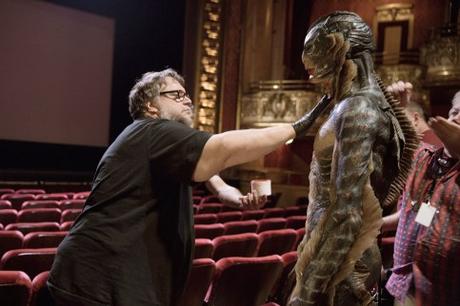
He has made movies about monsters since he first appeared on the scene with Cronos, but it's telling that it's often the human characters who feel the most cold-blooded. Viewers might remember the horrific sight of Pan's Labyrinth's Pale Man, but Captain Vidal feels even more terrifying, understanding a monster with a human face can be far more unsettling than a creature lurking in the dark. With that in mind, his newest film, The Shape of Water, might be his masterpiece. It's a fairytale for those who recognize the world's inherent darkness but hope decency can triumph.
Both a tribute to Hollywood's golden age of cinema and mixture of Beauty and the Beast and The Creature from the Black Lagoon, del Toro has created a narrative about the virtue of seeing beneath one's surface and the transformative power of emotional connection. In a cultural landscape where racists and misogynists have been given a renewed sense of prominence and representation by a race-baiting president who courts their support, The Shape of Water 's story of disenfranchised/disregarded individuals fighting back against an unjust authority (especially created by a Mexican director) feels like just the film I needed at the end of a long, frustrating year.
Set in the 1960s, during a time of Cold War paranoia and competitiveness between the US and USSR, the film centers around Elisa (a radiant Sally Hawkins), a janitor at a government facility. Elisa is mute due to the result of childhood abuse. She communicates through sign language, but she can hear everything around her. She has close friendships with Giles (Richard Jenkins), her closeted next-door neighbor and Zelda (Octavia Spencer), an African-American co-worker who translates her signing.
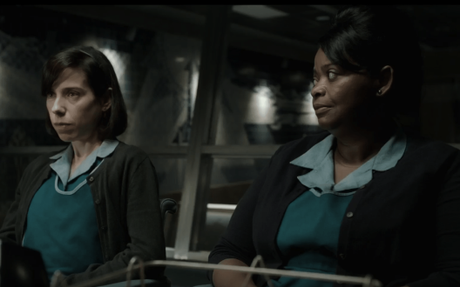
Elisa's life is routine, but she's no wilting flower. She laughs easily and early scenes show us she's comfortable with her own sexuality. She's the most at peace in her own skin. Others may see her as inferior, but she doesn't' feel that way about herself. This isn't a story about a woman finding herself through the love of another, but a story of a woman understanding she has the strength of character to fight against cruelty.
The supporting characters seem trapped by their own circumstances. Giles goes to a specific pie shop day after day, in order to flirt with the handsome man who works behind the counter but has nothing attractive beneath his exterior. Zelda seems stuck in a marriage she'd love to escape. They're trapped because they fall outside the norms in an era of conformity, thematically setting the stage for a movie that will ultimately be about those who don't fit into society taking a stand to defend another exploited individual, because they'd like the world to be better than they know it to be.
Everything changes when a creature is transported to the lab. Captured in the Amazon, the "asset" looks a bit like Hellboy 's Abe Sapien, and not just because both are played by the loose-limbed, lanky Doug Jones. He comes complete with gills, scales, human-esque legs, and large, expressive eyes. Colonel Richard Strickland (a typically monstrous Michael Shannon), the man in charge of learning all he can about the creature before disposing of it, sees it as an abomination.

He uses a cattle prod or other forms of abuse to extract what he needs, thinking it's a beast and nothing more. However, while cleaning up the facility, Elisa recognizes the creature is capable of wordless communication and intelligence. They form a bond over shared hard-boiled eggs and music on a record player.
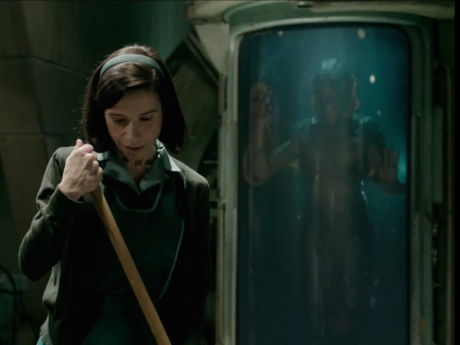
When she learns of an order to destroy it, she makes the decision to rescue it and return it to the sea, with Giles's assistance. She finds herself aided by a sympathetic doctor with complicated origins, Robert Hoffstetler (Michael Stuhlbarg), who also recognizes the creature has intelligence and capabilities beyond its aquatic exterior.
As stated earlier, The Shape of Water is a fairy-tale, but that's not a criticism. It's a story about venturing off the path, being changed for the better because of straying from the norm. Some fairy tales are about the perils of leaving civilization for the unknown, but the best fairy tales are about how wonderful such an adventure can be. Beyond that, though, it's a love letter to the joys and ecstasies that can be found in the glow of a movie screen. Elisa and Giles live above a movie theatre, where epic stories are advertised on an illuminated marquee. When a fantasy dance sequence unfolds before us, it feels in keeping with del Toro's love of cinema's past. Even the film's cinematography from Dan Laustsen looks beautiful, with a mixture of soft-focus lighting that makes scenes feel steeped in romance and noir-esque shadows that enhance the film's suspense. The use of underwater-type sequences enhance the film's dream-like quality.
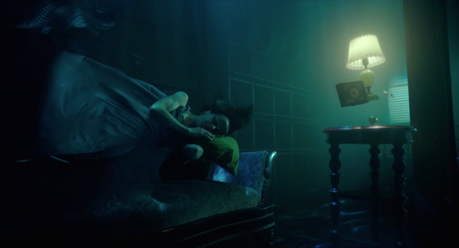
Performances are universally strong throughout. Doug Jones, a mime by trade, is able to convey love, hatred, remorse, and joy all through the use of body language (and digitally created eyes). Octavia Spencer does fine work in her supporting role, and Richard Jenkins is an always-welcome screen presence.
Michael Shannon's role is trickier, playing a man who is every bit the embodiment of early 1960s conformity. He's God-fearing, has children, reads The Power of Positive Thinking, drives a Cadillac, and resides in the comfort of suburbia, while also keeping his clearly monstrous ideas and impulses visible just beneath the surface. Whether he's torturing the creature in his lab or sexually harassing Elisa, anyone who worries Shannon might, in fact, be a real-life sociopath will find little evidence to the contrary here. There's nothing subtle about his performance, nor should there be, but his WASPy normalcy serves as the perfect counter-balance to the marginalized minorities working to defy him.
However, the film is Sally Hawkins' to command. Her wordless performance, a brilliant display of gestures, glances, and sign language is so poetically lovely. She is able to convey an array of emotions simply through the look in her eyes and the aggressiveness of her gestures, creating a character whose side you're on from the moment she steps onto the screen. It's among the best performances I've seen this year.
It's to del Toro's credit that the developing romance between Jones's creature and Hawkins's Elisa feels so involving and appropriate, rather than creepy and unseemly. Part of that comes from the creature's design. For all of Strickland's talk of abominations, the creature's design, with a well-defined musculature, blue-green amphibious skin, and those expressive eyes make it easy to see him as beautiful.
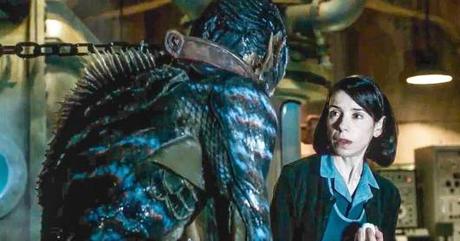
It's also the knowledge that the relationship blossoms through mutual understanding. As Elisa tells Giles when she first tries to convince him to aid in the creature's rescue, "When he looks at me, he does not know how I am incomplete. He sees me as I am." Both Elisa and the creature are individuals who bond without the obstacle of words, each capable of seeing the inner beauty within the other. They fall in love because of the kindness both show one another. Neither sees the other as inferior, and that's the reason the bond strengthens so slowly and delicately.
Ultimately, The Shape of Water is the work of a visionary director whose love of those who exist outside of society's norms has never diminished. He's not worried about portraying humanity's darker side, but his outlook is more optimistic than that. He sees the beauty in the monstrous and the strength in the vulnerable. He finds the humanity in those society refuses to acknowledge. There's a moment when Elisa is pleading for Giles to aid her, and he refuses, saying the creature isn't human. She signs back, "If we do nothing [to save him], neither are we." The Shape of Water is about that sense of compassion and understanding, and who truly is or isn't human. It has faith in the individual even as it distrusts authority. The film captured my attention from its opening and moved me with its narrative. As soon as it was over, I was ready to watch it all over again, and it's my favorite film of the year, because it reminded me that there can be those who defend those who cannot defend themselves.

